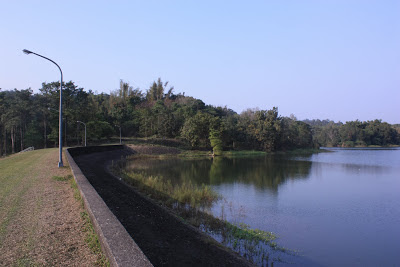Saturday, 9 February 2013
At Baihe & Luliao Reservoirs
So I spent yesterday morning and afternoon in Tainan's Baihe district (白河區) in order to photograph the back end of Baihe reservoir (白河水庫), one of Tainan's four major reservoirs and also to photograph nearby Luliao reservoir (鹿寮水庫), which is one of three minor reservoirs in Tainan (the other two being Mingjing reservoir [明鏡水庫] in Nanhua district [南化區] and Jianshanpi reservoir [(尖山埤水庫)] in Liuying district [柳營區]).
In driving out once again to the back end of Baihe reservoir, I was hoping to get some decent shots looking south-west down the fractured fork of water which forms the reservoir's north-eastern section. However, finding a good enough vantage point for such a shot escaped me once again - for the third time. One of the problems is that the google maps and google earth images of the area and its' roads are partially inaccurate whilst another problem is that access to several of these little roads is variously restricted by locked gates to a farmer's property, a busy temple and a local cemetery. Another problem is that many of the little roads lead to cul-de-sacs and were intended only for access to the banana trees. Despite that, I did manage to find a somewhat obstructed view down to, and perpendicularly across the reservoir's fork-section...
Unfortunately I was unable to find the entrance to the road running along the top of the escarpment in that last image above (or perhaps more likely, I did find it, but access was barred). I also found several more smaller jetties, including this one below which was flanked by a ramshackle port of sorts on the opposite (southern) bank...
Elsewhere along the reservoir's eastern edge, there were one or two places where the view was relatively unencumbered by foliage; the view below looks down across the reservoir's midway point with the north-eastern fork off to the right of the image, following the tree-topped escarpment behind the protuding flower bush...
The extent to which sediment has encroached into the basin of the reservoir over the decades since it was first filled with water is acutely obvious today; notice the large reed-bed to the right of the reservoir's second feeder stream in that image above. Despite the reservoir being massively bogged down in sediment and reeds, funds have still been made available to manage and restrict the rate of soil erosion, as evinced by the recent construction of retaining walls surmounted by gabions (wire-mesh boxes filled with stone and soil). These are accompanied by weirs and culverts to channel run-off water from the hills directly into the reservoir.
I also managed to take two or three very good shots of the crested serpent eagles that were circling me overhead throughout the morning...
Each of these shots (and many more, not quite as good) were taken after several episodes in which the eagles, a convocation of six, would pass over me at a low altitude and disappear before I could swap lenses in time. I have to stop making the mistake of leaving my 18mm lens attached to the camera whilst on the move - it should always be the 250mm attached, especially for this purpose. My previous best eagle shots are here and here. Later in the afternoon I had three more close encounters with the eagles, after unwittingly disturbing them on tree branches - on the first two occassions I had been following up another little farmer's road and hadn't known they were there until I rounded a corner and they took off right in front of me (perhaps no more than ten meters away) in full colour with the sunlight falling on them from behind me. On the third occasion, as the afternoon was drawing to a close, I noticed one of them on a tree branch out of the corner of my eye among a hill full of banana trees. By the time I quitely sneaked my camera out, he had took off.
I quit Baihe reservoir at some time after 3pm, when I finally accepted that I wasn't going to get onto that escarpment road I had been looking at earlier. On the way back I remembered that I had also had a good mind to check out Luliao reservoir once more; on my previous visit I had found the reservoir entrance road gated and locked. This time I talked to one of the locals in a nearby village who let me in on how to solve this little problem. In spite of apparently not being open to the public, Luliao reservoir is quite picturesque (although by the time I got there, the light was already past its' best)...
Other than a few of the usual "danger-deep-water" signs, there were no information panels there although there was a management office just below the crest of the dam. I would have called in to ask questions but I was running out of time. The approach road leading up to the reservoir from the front gate terminates at the dam crest, but there was also a footpath which seemed to snake around to the back (east) end of the reservoir. I'll have to make a return trip at some point and in better light.
新年快樂!
Subscribe to:
Post Comments (Atom)



















No comments:
Post a Comment
Comment moderation is now in place, as of April 2012. Rules:
1) Be aware that your right to say what you want is circumscribed by my right of ownership here.
2) Make your comments relevant to the post to which they are attached.
3) Be careful what you presume: always be prepared to evince your point with logic and/or facts.
4) Do not transgress Blogger's rules regarding content, i.e. do not express hatred for other people on account of their ethnicity, age, gender, sexual orientation or nationality.
5) Remember that only the best are prepared to concede, and only the worst are prepared to smear.